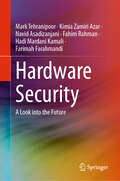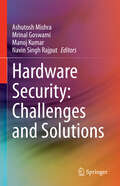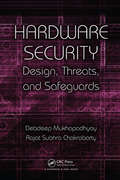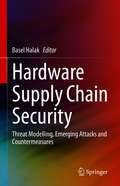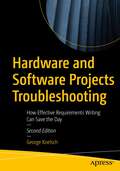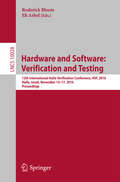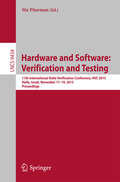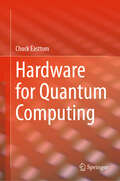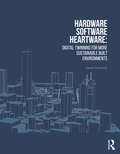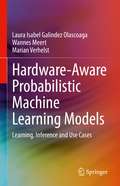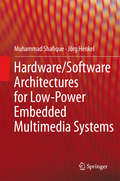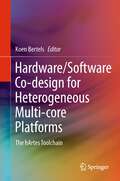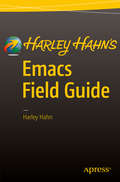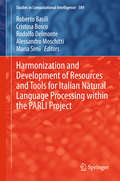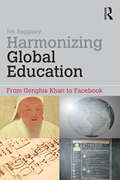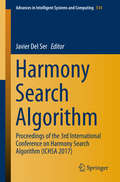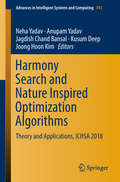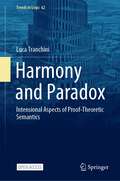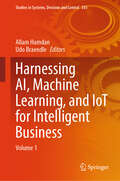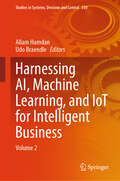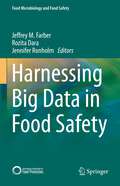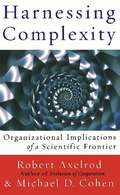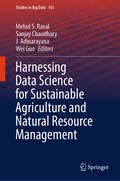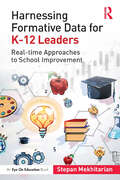- Table View
- List View
Hardware Security: A Look into the Future
by Mark Tehranipoor Farimah Farahmandi Navid Asadizanjani Kimia Zamiri Azar Hadi Mardani Kamali Fahim RahmanThis book provides a look into the future of hardware and microelectronics security, with an emphasis on potential directions in security-aware design, security verification and validation, building trusted execution environments, and physical assurance. The book emphasizes some critical questions that must be answered in the domain of hardware and microelectronics security in the next 5-10 years: (i) The notion of security must be migrated from IP-level to system-level; (ii) What would be the future of IP and IC protection against emerging threats; (iii) How security solutions could be migrated/expanded from SoC-level to SiP-level; (iv) the advances in power side-channel analysis with emphasis on post-quantum cryptography algorithms; (v) how to enable digital twin for secure semiconductor lifecycle management; and (vi) how physical assurance will look like with considerations of emerging technologies. The main aim of this book is to serve as a comprehensive and concise roadmap for new learners and educators navigating the evolving research directions in the domain of hardware and microelectronic securities. Overall, throughout 11 chapters, the book provides numerous frameworks, countermeasures, security evaluations, and roadmaps for the future of hardware security.
Hardware Security: Challenges and Solutions
by Manoj Kumar Ashutosh Mishra Navin Singh Rajput Mrinal GoswamiThis book provides a comprehensive overview of hardware security challenges and solutions, making it an essential resource for engineers, researchers, and students in the field. The authors cover a wide range of topics, from hardware design and implementation to attack models and countermeasures. They delve into the latest research and industry practices in the field, including techniques for secure chip design, hardware Trojan detection, side-channel attack mitigation, the threats and vulnerabilities facing modern hardware, the design and implementation of secure hardware, and the latest techniques for testing and verifying the security of hardware systems. The book also covers emerging technologies such as quantum computing and the Internet of Things, and their impact on hardware security. With its practical approach and extensive coverage of the subject, this book is an ideal reference for anyone working in the hardware security industry.
Hardware Security: Design, Threats, and Safeguards
by Rajat Subhra Chakraborty Debdeep MukhopadhyayDesign for security and meet real-time requirements with this must-have book covering basic theory, hardware design and implementation of cryptographic algorithms, and side channel analysis. Presenting state-of-the-art research and strategies for the design of very large scale integrated circuits and symmetric cryptosystems, the text discusses hardware intellectual property protection, obfuscation and physically unclonable functions, Trojan threats, and algorithmic- and circuit-level countermeasures for attacks based on power, timing, fault, cache, and scan chain analysis. Gain a comprehensive understanding of hardware security from fundamentals to practical applications.
Hardware Supply Chain Security: Threat Modelling, Emerging Attacks and Countermeasures
by Basel HalakThis book presents a new threat modelling approach that specifically targets the hardware supply chain, covering security risks throughout the lifecycle of an electronic system. The authors present a case study on a new type of security attack, which combines two forms of attack mechanisms from two different stages of the IC supply chain. More specifically, this attack targets the newly developed, light cipher (Ascon) and demonstrates how it can be broken easily, when its implementation is compromised with a hardware Trojan. This book also discusses emerging countermeasures, including anti-counterfeit design techniques for resources constrained devices and anomaly detection methods for embedded systems.
Hardware and Software Projects Troubleshooting: How Effective Requirements Writing Can Save the Day
by George KoelschLearn how to create good requirements when designing hardware and software systems. While this book emphasizes writing traditional “shall” statements, it also provides guidance on use case design and creating user stories in support of agile methodologies. The book surveys modelling techniques and various tools that support requirements collection and analysis. You’ll learn to manage requirements, including discussions of document types and digital approaches using spreadsheets, generic databases, and dedicated requirements tools. Good, clear examples are presented, many related to real-world work the author has performed during his career. More importantly, you will learn how these techniques can prevent the problems that occur during requirements development. Most of all, you will learn how good requirements governance will greatly increase the success of development projects by getting all people involved to eliminate the adverse impacts to requirements throughout the development lifecycle. Hardware and Software Projects Troubleshooting covers techniques for defining user needs, so you can determine which combination of approaches to use for your projects. You’ll also learn how to analyze the different development methodologies so that you can determine the advantages and disadvantages of different requirements approaches and implement them correctly as your needs evolve. Unlike most requirements books, this one teaches writing both hardware and software requirements because many projects include both areas. To exemplify this approach, two example projects are developed throughout the book, one focusing on hardware, and the other on software. What You Will Learn Focus on how to eliminate or mitigate requirements problemsUnderstand the 14 techniques for capturing all requirementsAddress software and hardware needs; because most projects involve bothEnsure all statements meet the 16 attributes of a good requirementDifferentiate the 19 different functional types of requirements, and the 31 non-functional typesWrite requirements properly based on extensive examples of good ‘shall’ statements, user stories, and use casesEmploy modelling techniques to mitigate the imprecision of wordsInstall requirements governance to significantly improve project success Who This Book Is For Requirements engineers who want to improve and master their craft, as well as students and those employed in government or other organizations at all levels.
Hardware and Software: Verification and Testing
by Roderick Bloem Eli ArbelThis book constitutes the refereed proceedings of the 12th International Haifa Verification Conference, HVC 2016, held in Haifa, Israel in November 2016. The 13 revised full papers and one tool paper presented were carefully reviewed and selected from 26 submissions. They are dedicated to advance the state of the art and state of the practice in verification and testing and are discussing future directions of testing and verification for hardware, software, and complex hybrid systems.
Hardware and Software: Verification and Testing
by Nir PitermanThis book constitutes the refereed proceedings of the11th International Haifa Verification Conference, HVC 2015, held in Haifa,Israel, in November 2015. The 17 revised full papers and 4 invited talks presentedwere carefully reviewed and selected from numerous submissions. The papers areorganized in topical sections on hybrid systems; tools; verification ofrobotics; symbolic execution; model checking; timed systems; SAT solving; multidomain verification; and synthesis.
Hardware for Quantum Computing
by Chuck EasttomThis book covers extensively the physical implementation of qubits and quantum architecture. The author demonstrates how quantum computing is implemented by the underlying physical implementation of qubits, including trapped ions, nitrogen vacancy centers, frozen neon, and other implementations. The book shows how, ultimately, the physical implementation of the qubit is the foundation of quantum computing, and that the choice of physical qubit will impact such things as decoherence times, computational efficiency, and even error rate. The book explores all the current approaches to physical qubit implementation and includes appendices that review basic quantum computing and physics.
Hardware, Software, Heartware: Digital Twinning for More Sustainable Built Environments
by Jason PomeroyThis richly illustrated book examines the full potential of Digital Twins (DTs) as a means of creating more sustainable urban habitats. It reveals how, in this digitally-enabled age, DTs are increasingly being adopted by cities as a tool for urban governance, with the hope of increasing operational efficiencies and enhancing citizens’ lives. While the study and implementation of DTs has been critically explored as virtual, dynamic 3D replicas of physical entities across different disciplines and industries, this book establishes a strategy that recognises the need for the ‘software’ behind virtual DT platforms to not only represent the ‘hardware’ of our physical cities but also to reflect the ‘heartware’ of socio-economic and cultural practices. Knowledge gaps and challenges in existing DTs are identified and insights into rethinking their purpose are provided to propose a new DT paradigm model for city-wide application. With multiple case studies illustrating the different concepts of DTs being applied in cities from Europe, North America, The Middle East, Asia and Oceania, the book highlights the reasons why and how DTs can play an integral role in the sustainability of our urban habitats. Beautifully designed and illustrated in full colour throughout, this book combines academic theory with practical application and will be a useful reference for professionals, students, academics and policymakers, working in the fields of smart cities, sustainable urbanism, and the digitisation, digitalisation and digital transformation of the built environment industry.
Hardware-Aware Probabilistic Machine Learning Models: Learning, Inference and Use Cases
by Marian Verhelst Wannes Meert Laura Isabel Galindez OlascoagaThis book proposes probabilistic machine learning models that represent the hardware properties of the device hosting them. These models can be used to evaluate the impact that a specific device configuration may have on resource consumption and performance of the machine learning task, with the overarching goal of balancing the two optimally. The book first motivates extreme-edge computing in the context of the Internet of Things (IoT) paradigm. Then, it briefly reviews the steps involved in the execution of a machine learning task and identifies the implications associated with implementing this type of workload in resource-constrained devices. The core of this book focuses on augmenting and exploiting the properties of Bayesian Networks and Probabilistic Circuits in order to endow them with hardware-awareness. The proposed models can encode the properties of various device sub-systems that are typically not considered by other resource-aware strategies, bringing about resource-saving opportunities that traditional approaches fail to uncover. The performance of the proposed models and strategies is empirically evaluated for several use cases. All of the considered examples show the potential of attaining significant resource-saving opportunities with minimal accuracy losses at application time. Overall, this book constitutes a novel approach to hardware-algorithm co-optimization that further bridges the fields of Machine Learning and Electrical Engineering.
Hardware/Software Architectures for Low-Power Embedded Multimedia Systems
by Jörg Henkel Muhammad ShafiqueThis book presents techniques for energy reduction in adaptive embedded multimedia systems, based on dynamically reconfigurable processors. The approach described will enable designers to meet performance/area constraints, while minimizing video quality degradation, under various, run-time scenarios. Emphasis is placed on implementing power/energy reduction at various abstraction levels. To enable this, novel techniques for adaptive energy management at both processor architecture and application architecture levels are presented, such that both hardware and software adapt together, minimizing overall energy consumption under unpredictable, design-/compile-time scenarios.
Hardware/Software Co-design for Heterogeneous Multi-core Platforms: The hArtes Toolchain
by Koen BertelsHW/SW Co-Design for Heterogeneous Multi-Core Platforms describes the results and outcome of the FP6 project which focuses on the development of an integrated tool chain targeting a heterogeneous multi core platform comprising of a general purpose processor (ARM or powerPC), a DSP (the diopsis) and an FPGA. The tool chain takes existing source code and proposes transformations and mappings such that legacy code can easily be ported to a modern, multi-core platform. Downloadable software will be provided for simulation purposes.
Harley Hahn's Emacs Field Guide
by Harley HahnEmacs, the world's most powerful text editor-based work environment, is easy to use, but far from easy to learn. As such, integrating Emacs into your personal world of thinking and creating is a long-term process. Harley Hahn, one of the most respected technical authors in the world, makes learning fun and stimulating. In this book, Hahn demystifies Emacs for programmers, students, and everyday users. The first part of the book carefully creates a context for your work with Emacs. What exactly is Emacs? How does it relate to your personal need to work quickly and to solve problems? Hahn then explains the technical details you need to understand to work with your operating system, the various interfaces, and your file system. In the second part of the book, Hahn provides an authoritative guide to the fundamentals of thinking and creating within the Emacs environment. You start by learning how to install and use Emacs with Linux, BSD-based Unix, Mac OS X, or Microsoft Windows. Written with Hahn's clear, comfortable, and engaging style, Harley Hahn's Emacs Field Guide will surprise you: an engaging book to enjoy now, a comprehensive reference to treasure for years to come. What you'll learn Special Emacs keys Emacs commands Buffers and windows Cursor, point, and region Kill/delete, move/copy, correcting, spell checking, and filling Searching, including regular expressions Emacs major modes and minor modes Customizing using your . emacs file Built-in tools, including Dired Games and Diversions Who this book is for Harley Hahn's Emacs Field Guide' is for programmers, students, and everyday users, who want an engaging and authoritative introduction to the complex and powerful Emacs working environment.
Harmonization and Development of Resources and Tools for Italian Natural Language Processing within the PARLI Project
by Roberto Basili Cristina Bosco Rodolfo Delmonte Alessandro Moschitti Maria SimiThe papers collected in this volume are selected as a sample of the progress in Natural Language Processing (NLP) performed within the Italian NLP community and especially attested by the PARLI project. PARLI (Portale per l'Accesso alle Risorse in Lingua Italiana) is a project partially funded by the Ministero Italiano per l'Università e la Ricerca (PRIN 2008) from 2008 to 2012 for monitoring and fostering the harmonic growth and coordination of the activities of Italian NLP. It was proposed by various teams of researchers working in Italian universities and research institutions. According to the spirit of the PARLI project, most of the resources and tools created within the project and here described are freely distributed and they did not terminate their life at the end of the project itself, hoping they could be a key factor in future development of computational linguistics.
Harmonizing Global Education: From Genghis Khan to Facebook (Open and Flexible Learning Series)
by Jon BaggaleyDistance education (DE) offers ways to reach the many people around the world who lack access to education and training by other means. International DE methods, however, are fragmented, and distance educators have often abandoned new technologies before giving them a chance to develop. As a result, many current DE tools and techniques are incompatible with the needs and cultures of different global regions. With the goal of designing efficient, relevant DE for worldwide audiences, Harmonizing Global Education invites scholars and practitioners to consider the historic development of technology-based education and communication studies, going back further in the literature than is often assumed necessary. The book examines a wide range of historical ideas capable of shaping modern DE, including the Luddite Revolt among British textiles workers in 1811-12, the evolution of cubist art and musical aesthetics, and the visionary advances of early twentieth-century Soviet multimedia specialists. The author urges an awareness of previous generations of communications studies, and shows how audience research relating to traditional media can be relevant in the design of current internet-based and social media approaches. Today's open universities have grown from these earlier historical efforts, and the future success of open and distance education depends on learning from the successes and the failures of the past.
Harmony Search Algorithm
by Javier Del SerThis book presents state-of-the-art technical contributions based around one of the most successful evolutionary optimization algorithms published to date: Harmony Search. Contributions span from novel technical derivations of this algorithm to applications in the broad fields of civil engineering, energy, transportation & mobility and health, among many others and focus not only on its cross-domain applicability, but also on its core evolutionary operators, including elements inspired from other meta-heuristics. The global scientific community is witnessing an upsurge in groundbreaking, new advances in all areas of computational intelligence, with a particular flurry of research focusing on evolutionary computation and bio-inspired optimization. Observed processes in nature and sociology have provided the basis for innovative algorithmic developments aimed at leveraging the inherent capability to adapt characterized by various animals, including ants, fireflies, wolves and humans. However, it is the behavioral patterns observed in music composition that motivated the advent of the Harmony Search algorithm, a meta-heuristic optimization algorithm that over the last decade has been shown to dominate other solvers in a plethora of application scenarios. The book consists of a selection of the best contributions presented at ICHSA, a major biannual event where leading global experts on meta-heuristic optimization present their latest findings and discuss the past, present, and future of the exciting field of Harmony Search optimization. It provides a valuable reference resource for researchers working in the field of optimization meta-heuristics, and a solid technical base for frontline investigations around this algorithm.
Harmony Search and Nature Inspired Optimization Algorithms: Theory and Applications, ICHSA 2018 (Advances in Intelligent Systems and Computing #741)
by Neha Yadav Anupam Yadav Kusum Deep Jagdish Chand Bansal Joong Hoon KimThe book covers different aspects of real-world applications of optimization algorithms. It provides insights from the Fourth International Conference on Harmony Search, Soft Computing and Applications held at BML Munjal University, Gurgaon, India on February 7–9, 2018. It consists of research articles on novel and newly proposed optimization algorithms; the theoretical study of nature-inspired optimization algorithms; numerically established results of nature-inspired optimization algorithms; and real-world applications of optimization algorithms and synthetic benchmarking of optimization algorithms.
Harmony and Paradox: Intensional Aspects of Proof-Theoretic Semantics (Trends in Logic #62)
by Luca TranchiniThis open access book investigates the role played by identity of proofs in proof-theoretic semantics. It develops a conception of proof-theoretic semantics as primarily concerned with the relationship between proofs (understood as abstract entities) and derivations (the linguistic representations of proofs). It demonstrates that identity of proof is a key both to clarify some —still not wholly understood— notions at the core of proof-theoretic semantics, such as harmony; and to broaden the range of the phenomena which can be analyzed using the tools of this semantic paradigm, so as to include for instance paradoxes.The volume covers topics such as the philosophical significance of different criteria of identity of proofs, and adequacy conditions for an intensional account of the notion of harmony. The author also examines the Prawitz-Tennant analysis of paradoxes by investigating on the one hand the prospectsof turning it into a theory of meaning for paradoxical languages, and on the other hand two distinct kinds of phenomena, first observed by Crabbe and Ekman, showing that the Tennant-Prawitz criterion for paradoxicality overgenerates. This volume is of interest to scholars in formal and philosophical logic.
Harnessing AI, Machine Learning, and IoT for Intelligent Business: Volume 1 (Studies in Systems, Decision and Control #555)
by Allam Hamdan Udo BraendleThis book is a comprehensive guide that explores the integration of artificial intelligence (AI), machine learning (ML), and the Internet of Things (IoT) in the realm of business management and finance. The convergence of AI, ML, and IoT has revolutionized various industries, and business management and finance are no exceptions. This book addresses the growing need for understanding the practical implications of these technologies in the context of financial management. It equips both academics and industry professionals with the knowledge and tools necessary to navigate the changing landscape and effectively harness these technologies to gain a competitive edge. This book delves into the transformative potential of these technologies and provides valuable insights into their application in decision-making, risk management, financial analysis, and strategic planning. It offers a holistic perspective on how organizations can leverage AI, ML, and IoT to drive innovation, enhance operational efficiency, and achieve sustainable growth in the digital age.
Harnessing AI, Machine Learning, and IoT for Intelligent Business: Volume 2 (Studies in Systems, Decision and Control #550)
by Allam Hamdan Udo BraendleThis book addresses the growing need for understanding the practical implications of these technologies in the context of financial management. The convergence of AI, ML, and IoT has revolutionized various industries, and business management and finance are no exceptions. This book equips both academics and industry professionals with the knowledge and tools necessary to navigate the changing landscape and effectively harness these technologies to gain a competitive edge. "Intelligent Business" is a comprehensive guide that explores the integration of artificial intelligence (AI), machine learning (ML), and the Internet of Things (IoT) in the realm of business management and finance. This book delves into the transformative potential of these technologies and provides valuable insights into their application in decision-making, risk management, financial analysis, and strategic planning. It offers a holistic perspective on how organizations can leverage AI, ML, and IoT to drive innovation, enhance operational efficiency, and achieve sustainable growth in the digital age.
Harnessing Big Data in Food Safety (Food Microbiology and Food Safety)
by Jeffrey M. Farber Rozita Dara Jennifer RonholmBig Data technologies have the potential to revolutionize the agriculture sector, in particular food safety and quality practices. This book is designed to provide a foundational understanding of various applications of Big Data in Food Safety. Big Data requires the use of sophisticated approaches for cleaning, processing and extracting useful information to improve decision-making. The contributed volume reviews some of these approaches and algorithms in the context of real-world food safety studies. Food safety and quality related data are being generated in large volumes and from a variety of sources such as farms, processors, retailers, government organizations, and other industries. The editors have included examples of how big data can be used in the fields of bacteriology, virology and mycology to improve food safety. Additional chapters detail how the big data sources are aggregated and used in food safety and quality areas such as food spoilage and quality deterioration along the supply chain, food supply chain traceability, as well as policy and regulations. The volume also contains solutions to address standardization, data interoperability, and other data governance and data related technical challenges. Furthermore, this volume discusses how the application of machine-learning has successfully improved the speed and/or accuracy of many processes in the food supply chain, and also discusses some of the inherent challenges. Included in this volume as well is a practical example of the digital transformation that happened in Dubai, with a particular emphasis on how data is enabling better decision-making in food safety. To complete this volume, researchers discuss how although big data is and will continue to be a major disruptor in the area of food safety, it also raises some important questions with regards to issues such as security/privacy, data control and data governance, all of which must be carefully considered by governments and law makers.
Harnessing Complexity: Organizational Implications of a Scientific Frontier
by Robert Axelrod Michael D. CohenHarnessing Complexity will be indispensable to anyone who wants to better comprehend how people and organizations can adapt effectively in the information age. This book is a step-by-step guide to understanding the processes of variation, interaction, and selection that are at work in all organizations. The authors show how to use their own paradigm of "bottom up" management, the Complex Adaptive System-whether in science, public policy, or private commerce. This simple model of how people work together will change forever how we think about getting things done in a group. "Harnessing Complexity distills the managerial essence of current research on complexity. #133;A very valuable contribution to the emerging theory of competition and competitive advantage. "-C. K. Prahalad, University of Michigan, coauthor of Competing for the Future"A brilliant exposition that demystifies both the theory and use of Complex Adaptive Systems. "-John Seely Brown, Xerox Corporation and Palo Alto Research Center
Harnessing Data Science for Sustainable Agriculture and Natural Resource Management (Studies in Big Data #161)
by Sanjay Chaudhary Mehul S. Raval Wei Guo J. AdinarayanaThis book is a comprehensive resource that handles the issues of sustainable agriculture and natural resource management, aligned with the United Nations' Sustainable Development Goals (SDGs). The book is organized into five sections, Understanding the Problem, Data Collection and Cleaning, Exploratory Data Analysis and Visualization, Model Building, and Model Deployment. Each section covers a critical aspect of data science in this context and addresses specific SDGs 2—zero hunger, 6—clean water and sanitation, 12—responsible consumption and production, 13—climate action, and 15—Life on land. The organized sections are arranged to seamlessly follow the data science pipeline and provide practical guidance from problem understanding to its model deployment and stakeholder management. The book is useful for researchers, students, practitioners, and policymakers.
Harnessing Formative Data for K-12 Leaders: Real-time Approaches to School Improvement
by Stepan MekhitarianHarnessing Formative Data for K-12 Leaders prepares school and district leaders to re-evaluate how real-time formative data can inform policy, planning, and professional development. The importance of effective formative data use has escalated since the expansion of distance learning and the integration of digital education tools, which have impacted the consistency, accuracy, availability, and actionability of data points that leaders rely on. This book’s strategic insights into actionable, organizational-level formative data use will yield differentiated supports for schools to foster greater academic outcomes, a culture of equity and social-emotional well-being, and students’ readiness for college, career, and lifelong learning. Each chapter includes connections to social justice, best practices for applying data points and field-tested tips for technology integration, and a host of interactive planning guides to support implementation.
Harnessing Formative Data for K-12 Leaders: Real-time Approaches to School Improvement
by Stepan MekhitarianHarnessing Formative Data for K-12 Leaders prepares school and district leaders to re-evaluate how real-time formative data can inform policy, planning, and professional development. The importance of effective formative data use has escalated since the expansion of distance learning and the integration of digital education tools, which have impacted the consistency, accuracy, availability, and actionability of data points that leaders rely on. This book’s strategic insights into actionable, organizational-level formative data use will yield differentiated supports for schools to foster greater academic outcomes, a culture of equity and social-emotional well-being, and students’ readiness for college, career, and lifelong learning. Each chapter includes connections to social justice, best practices for applying data points and field-tested tips for technology integration, and a host of interactive planning guides to support implementation.
